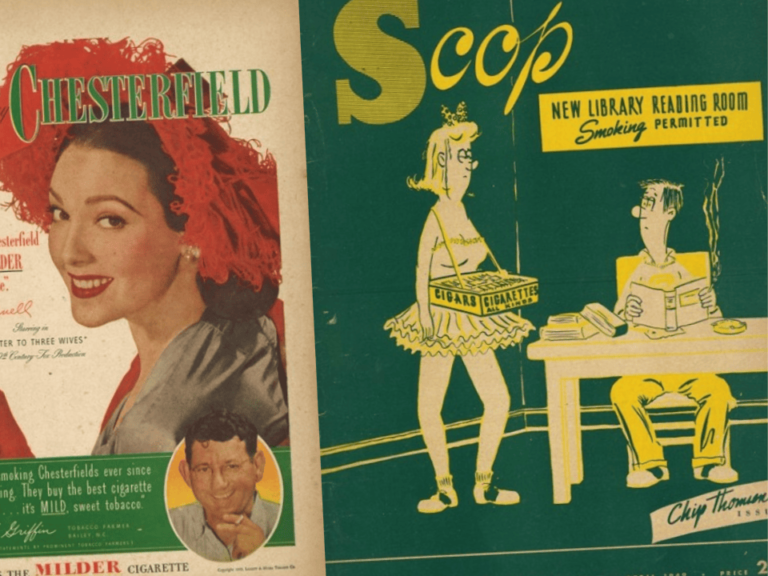Alan Blum, director of The Center for the Study of Tobacco and Society, documents King Charles’s track record of anti-smoking advocacy, which represents a break with the royal family’s history with tobacco.
The center has put together an online exhibit documenting the role tobacco companies have played in earlier coronations and the lives of members of the royal family.
- Coronations, cigarette companies, and cancer
By The Center for the Study of Tobacco and Society | May 5, 2023


“Have you not reason then to bee ashamed, and to forbeare this filthie noveltie, so basely grounded, so foolishly received and so grossely mistaken in the right use thereof? In your abuse thereof sinning against God, harming your selves both in persons and goods, and raking also thereby the markes and notes of vanitie upon you: by the custome thereof making your selves to be wondered at by all forraine civil Nations, and by all strangers that come among you, to be scorned and contemned. A custome lothsome to the eye, hatefull to the Nose, harmefull to the braine, dangerous to the Lungs, and in the blacke stinking fume thereof, neerest resembling the horrible Stigian smoke of the pit that is bottomelesse…” – King James I of England in 1604, A Counterblaste to Tobacco
Written by King James I of England in 1604, A Counterblaste to Tobacco is one of the earliest diatribes against smoking. In it he decries having to breathe in other people’s smoke, rails against its stench, and warns of the dangers to the lungs.
James’s disdain for the noxious plant led him to levy a heavy excise tax on tobacco brought from North America, but 20 years later the ever-increasing demand for tobacco led him to do an about-face and create a royal monopoly for the crop.
Over the ensuing three centuries, tobacco would be a mainstay of the British economy, and Great Britain would be the leading tobacco merchant to the world.
In 1877, possibly by appealing to the love of smoking by Prince Albert, Queen Victoria’s consort, and creating a brand of pipe mixture named for him, tobacco manufacturer Gallaher Limited was permitted to include the coat of arms of British monarchs on its cigarette packages.
Over the next century, cigarette makers used every opportunity to associate themselves and their products with luxury… and royalty. During World War I, when cigarettes usurped cigars as the tobacco product of choice by young men, members of the royal family lent their name and image to the distribution of cigarettes to the boys in the trenches and wounded soldiers in hospitals.
In 1937, Imperial Tobacco, maker of the most popular brand of cigarettes, Player’s, issued an album of tobacco trading cards—a popular hobby among boys—to commemorate the coronation of King George VI and Queen Elizabeth.
To honor Queen Elizabeth II at her coronation in 1953, Tobacco, the leading journal of the trade, published A History of Smoking from Elizabeth I to Elizabeth II.
To burnish their nicotine-stained image throughout the latter half of the 20th century and beyond, British cigarette companies became patrons of the arts and universities, as well as major sponsors of televised sporting events.


During Prince Charles’ and Princess Diana’s visit to Australia in 1983, Gallaher tied one of its cigarettes brands to the royal family in an infamous souvenir front page of The Sydney Morning Herald that featured an advertisement for Benson & Hedges.
The previous year, the South-African based cigarette company Rothmanns also tied its Dunhill cigarette brand to an international showjumping event “to be held in the presence of His Royal Highness, the Duke of Edinburgh.”
Consider the devastating reality of smoking not just on the nation—cigarettes are still the leading preventable cause of death in Great Britain in 2023, killing 76,000 a year—but also on the royal family: Queen Elizabeth’s father, George VI, was just 52 when he died from lung cancer. His father, George V, and grandfather, Edward VII, also died of smoking-related diseases, as did his granduncle Edward VIII, the Duke of Windsor. Queen Elizabeth’s sister, Princess Margaret, who smoked heavily, died at 71 from severe lung and heart disease.


Doubtless mindful of the devastating toll taken by smoking on his own family, Prince Charles became an outspoken anti-smoking advocate.
Read more on the Cancer History Project.
Contributor spotlight: Johns Hopkins Kimmel Cancer Center


- Video: 50th Anniversary of the Johns Hopkins Kimmel Cancer Center
By Johns Hopkins Kimmel Cancer Center | May 8, 2023
2023 marks the 50th Anniversary of the cancer center at Johns Hopkins. Throughout those 50 years, Hopkins physicians and scientists have led the way with both excellent treatment and breakthrough research that define the field.
Click here to view the video about the 50th anniversary of John Hopkins’ Kimmel Cancer Center.


- Podcast: 50th Anniversary of the Johns Hopkins Kimmel Cancer Center Podcast Series – The Founding of the Cancer Center
By Johns Hopkins Kimmel Cancer Center | May 10, 2023
2023 marks the 50th anniversary of the founding of the Cancer Center at Johns Hopkins. In recognition, this year will feature a series of podcasts looking back at the individuals that made our institution what it is today.
This podcast episode features Bill Nelson, director of Sidney Kimmel Comprehensive Cancer Center at Johns Hopkins, and professor of oncology, speaking to Jonathan Simons about the first leaders of the cancer center, Albert Owens and Donald Coffey.
This column features the latest posts to the Cancer History Project by our growing list of contributors.
The Cancer History Project is a free, web-based, collaborative resource intended to mark the 50th anniversary of the National Cancer Act and designed to continue in perpetuity. The objective is to assemble a robust collection of historical documents and make them freely available.
Access to the Cancer History Project is open to the public at CancerHistoryProject.com. You can also follow us on Twitter at @CancerHistProj, or follow our podcast.
Is your institution a contributor to the Cancer History Project? Eligible institutions include cancer centers, advocacy groups, professional societies, pharmaceutical companies, and key organizations in oncology.
To apply to become a contributor, please contact admin@cancerhistoryproject.com.










